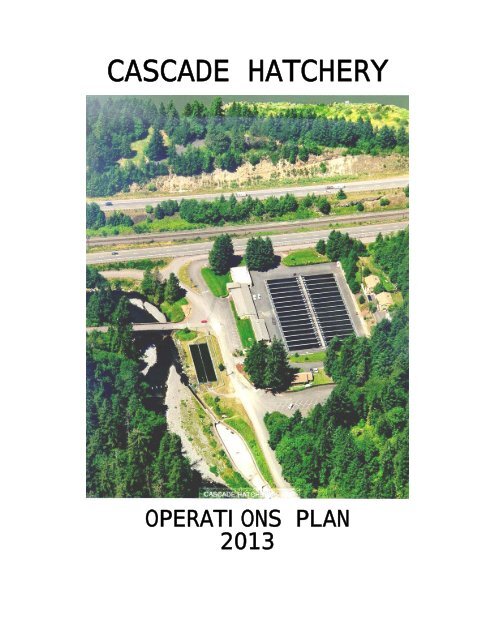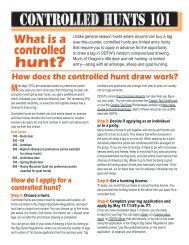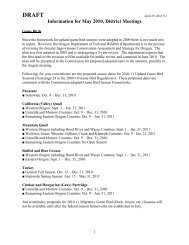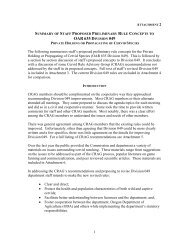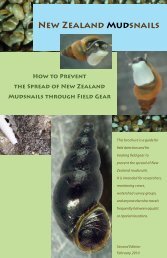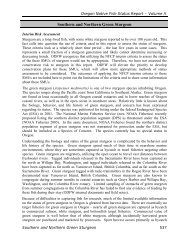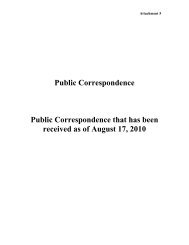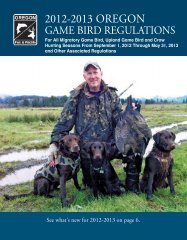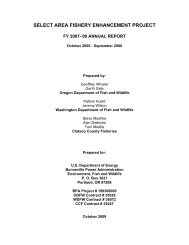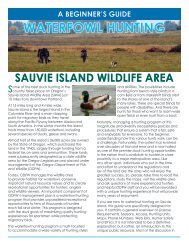Cascade Hatchery - Oregon Department of Fish and Wildlife
Cascade Hatchery - Oregon Department of Fish and Wildlife
Cascade Hatchery - Oregon Department of Fish and Wildlife
Create successful ePaper yourself
Turn your PDF publications into a flip-book with our unique Google optimized e-Paper software.
CASCADE HATCHERY<br />
OPERATIONS PLAN<br />
2013
<strong>Cascade</strong> <strong>Hatchery</strong><br />
INTRODUCTION<br />
<strong>Cascade</strong> <strong>Hatchery</strong> is located along Eagle Creek, 2.5 miles west <strong>of</strong> <strong>Cascade</strong> Locks, <strong>Oregon</strong>, <strong>of</strong>f <strong>of</strong><br />
Interstate 84 (Exit 41). The site is located at an elevation <strong>of</strong> 100 feet above sea level, at latitude 45 o<br />
38’ 30” N (45.64167) <strong>and</strong> longitude 121 o 55’ 33” W (121.9258). The area <strong>of</strong> the site is 3.8 acres,<br />
owned by US Forest Service, Mt. Hood National Forest District.<br />
Water is supplied by gravity flow from Eagle Creek. The total water right is 20,205 gpm.<br />
The hatchery is staffed with 5.75 FTE’s.<br />
Rearing Facilities at <strong>Cascade</strong> <strong>Hatchery</strong><br />
Unit Unit Unit Unit Unit Number Total Construction<br />
Type Length Width Depth Volume Units Volume Material Age Condition Comment<br />
(ft) (ft) (ft) (ft 3 ) (ft 3 )<br />
Adult Holding Pond 210 35 4 22,050 1 22,050 concrete 1960 fair Very irregular shape<br />
Raceways 78 16 2.5 3,120 30 93,600 concrete 1960 fair<br />
Deep Troughs 16 1.42 1.25 28 5 140 Fiberglass 1985 good Not used for incubation<br />
Vertical Incubators 990 Various fair 66 stacks <strong>of</strong> 15 trays<br />
PURPOSE<br />
<strong>Cascade</strong> <strong>Hatchery</strong> was authorized under the Mitchell Act <strong>and</strong> began operating in 1959 as part <strong>of</strong> the<br />
Columbia River <strong>Fish</strong>eries Development Program – a program to enhance declining fish runs in the<br />
Columbia River Basin. The facility is used for egg incubation <strong>and</strong> rearing <strong>of</strong> coho.<br />
PROGRAM TYPE<br />
The ODFW <strong>Hatchery</strong> Management Policy defines hatchery programs as either harvest or<br />
conservation programs. Harvest programs operate to enhance or maintain fisheries without<br />
impairing naturally reproducing populations. Conservation programs operate to maintain or<br />
increase the number <strong>of</strong> naturally produced fish without reducing the productivity <strong>of</strong> naturally<br />
reproducing populations.<br />
<strong>Cascade</strong> <strong>Hatchery</strong> participates in both harvest <strong>and</strong> conservation programs. The Tanner Creek (014)<br />
Coho program is a harvest program used to mitigate for the loss <strong>of</strong> fishing <strong>and</strong> harvest<br />
opportunities due to habitat loss <strong>and</strong> migration blockage resulting from the Columbia Basin<br />
hydropower system. The Mid-Columbia/Leavenworth (508) Coho program <strong>and</strong> the Umatilla River<br />
(091) Coho Program are conservation programs for the restoration <strong>of</strong> extirpated populations.<br />
<strong>Cascade</strong> <strong>Hatchery</strong> Plan Page 1
GOALS<br />
Tanner Creek (014) Coho: Produce fish to help meet the goals <strong>of</strong> the Columbia River <strong>Fish</strong><br />
Management Plan (U.S. v. <strong>Oregon</strong> Agreement).<br />
Umatilla River (091) Coho: Produce fish from a locally-adapted broodstock for a restoration<br />
program to reintroduce coho into the Umatilla River Basin <strong>and</strong> establish ocean <strong>and</strong> in-river harvest<br />
opportunities.<br />
Mid-Columbia/Leavenworth (508) Coho: Produce fish for a restoration program to reintroduce<br />
coho into the Wenatchee River Basin.<br />
Clackamas River (019) Spring Chinook: Produce fish to mitigate for loss <strong>of</strong> spring Chinook catch in<br />
sport <strong>and</strong> commercial fisheries due to loss <strong>of</strong> habitat quantity <strong>and</strong> quality due to construction <strong>and</strong><br />
operation <strong>of</strong> PGE on the Clackamas River <strong>and</strong> USACE hydropower dams on the Columbia River.<br />
OBJECTIVES<br />
Objective 1:<br />
Foster <strong>and</strong> sustain opportunities for sport, commercial, <strong>and</strong> tribal fishers consistent<br />
with the conservation <strong>of</strong> naturally produced native fish.<br />
Coho:<br />
Tanner Creek (014) Stock:<br />
Produce 1,592,000 coho fingerlings (12,061 pounds) for transfer to Upper Herman Creek<br />
Ponds (Oxbow <strong>Hatchery</strong>).<br />
Produce 540,000 fingerlings (3,600 pounds) for transfer to Clackamas <strong>Hatchery</strong>.<br />
Umatilla River (091) Stock:<br />
Produce 1,000,000 smolts (66,667 pounds) for release into the Umatilla River System.<br />
Mid-Columbia/Leavenworth (508) Stock:<br />
Produce 196,500 smolts (9,825 pounds) for release into the Wenatchee River System.<br />
Produce 437,500 fish (16,767 pounds) for transfer to Leavenworth National <strong>Fish</strong> <strong>Hatchery</strong>.<br />
Spring Chinook:<br />
Produce 250,000 fingerlings (1,667 pounds) for transfer to Clackamas <strong>Hatchery</strong>.<br />
Objective 2: Contribute toward the sustainability <strong>of</strong> naturally produced native fish populations<br />
through the responsible use <strong>of</strong> hatcheries <strong>and</strong> hatchery-produced fish.<br />
Objective 3:<br />
Maintain genetic resources <strong>of</strong> native fish populations spawned or reared in captivity.<br />
<strong>Cascade</strong> <strong>Hatchery</strong> Plan Page 2
Objective 4: Restrict the introduction, amplification, or dissemination <strong>of</strong> disease agents in<br />
hatchery produced fish <strong>and</strong> in natural environments by controlling egg <strong>and</strong> fish<br />
movements <strong>and</strong> by prescribing a variety <strong>of</strong> preventative, therapeutic <strong>and</strong> disinfecting<br />
strategies to control the spread <strong>of</strong> disease agents in fish populations in the state.<br />
Objective 5:<br />
Objective 6:<br />
Minimize adverse ecological impacts to watersheds caused by hatchery facilities <strong>and</strong><br />
operations.<br />
Communicate effectively with other fish producers, managers <strong>and</strong> the public.<br />
CURRENT PRACTICES TO ACHIEVE OBJECTIVES<br />
The sections that follow describe the current hatchery practices used at this facility. Because<br />
ODFW hatcheries are managed to maximize use <strong>of</strong> the hatchery rearing space, hatchery operations<br />
are dynamic <strong>and</strong> subject to annual change depending upon statewide program needs.<br />
The Native <strong>Fish</strong> Conservation Policy, the <strong>Fish</strong> <strong>Hatchery</strong> Management Policy, the <strong>Fish</strong> Health<br />
Management Policy <strong>and</strong> <strong>Hatchery</strong> Genetic Management Plans provide guidelines for the<br />
management <strong>of</strong> wild <strong>and</strong> hatchery fish in <strong>Oregon</strong>. These policies describe the brood collection,<br />
rearing, release, <strong>and</strong> health management strategies currently used at this facility.<br />
Objective 1: Foster <strong>and</strong> sustain opportunities for sport, commercial, <strong>and</strong> tribal<br />
fishers consistent with the conservation <strong>of</strong> naturally produced native<br />
fish.<br />
Adult Collection<br />
Coho:<br />
Tanner Creek (014) Stock: Adult coho (Eagle Creek/Tanner Creek stock) return to Eagle<br />
Creek from late September to mid-November. Spawning occurs in October <strong>and</strong> November<br />
with a peak in November. No adult fish are collected at the hatchery. All adult fish are<br />
collected <strong>and</strong> spawned at Bonneville <strong>Hatchery</strong>. There is some adult salmon escapement<br />
above the hatchery.<br />
Umatilla River (091) Stock: Adults are collected <strong>and</strong> held at Three Mile Falls Dam; see the<br />
Umatilla <strong>Hatchery</strong> plan for details.<br />
Mid-Columbia/Leavenworth (508) Stock: No adults are collected at the hatchery; eggs are<br />
received from Methow <strong>Hatchery</strong> in December.<br />
Spring Chinook:<br />
Clackamas River (019) Stock: No adult fish are collected at <strong>Cascade</strong> <strong>Hatchery</strong>; see the<br />
Clackamas <strong>Hatchery</strong> Plan for details. Fingerlings are received from Oxbow <strong>Hatchery</strong> in<br />
early June.<br />
<strong>Cascade</strong> <strong>Hatchery</strong> Plan Page 3
Objective 2: Contribute toward the sustainability <strong>of</strong> naturally produced native fish<br />
populations through the responsible use <strong>of</strong> hatcheries <strong>and</strong> hatcheryproduced<br />
fish.<br />
Rearing <strong>and</strong> Release Strategies<br />
Rearing <strong>and</strong> release strategies are designed to limit the amount <strong>of</strong> ecological interactions occurring<br />
between hatchery <strong>and</strong> naturally produced fish. <strong>Fish</strong> are reared to sufficient size that smoltification<br />
occurs within nearly the entire population, which will reduce the retention time in downstream<br />
migration. Rearing on parent river water, or acclimation to parent river water for several weeks, is<br />
used to ensure strong homing to the hatchery, thus reducing the stray rate to natural populations.<br />
Various release strategies are used to ensure that fish migrate from the hatchery with least amount<br />
<strong>of</strong> interaction with native populations. The specific rearing <strong>and</strong> release strategies used at this<br />
hatchery are outlined below.<br />
Coho:<br />
Tanner Creek (014) Stock:<br />
Rear 1,592,000 fingerlings to a size <strong>of</strong> 132 fish/pound for transfer to Upper Herman Creek<br />
in late June. All fish are fin-clipped prior to transfer.<br />
Rear 540,000 fingerlings to a size <strong>of</strong> 150 fish/pound for transfer to Clackamas <strong>Hatchery</strong> in<br />
June. All fish are fin-clipped <strong>and</strong> 25,000 are coded-wire tagged prior to transfer.<br />
Umatilla River (091) Stock:<br />
Rear 1,000,000 smolts to a size <strong>of</strong> 15 fish/pound for transfer to Umatilla Acclimation site in<br />
mid-March for acclimation <strong>and</strong> release into the Umatilla River. 900,000 fish are fin-clipped<br />
<strong>and</strong> 100,000 are coded-wire tagged prior to transfer.<br />
Mid-Columbia/Leavenworth (508) Stock:<br />
These programs change each year as the needs are reassessed.<br />
Rear 110,000 fingerlings to a size <strong>of</strong> 30 fish/pound for transfer to Leavenworth National<br />
<strong>Fish</strong> <strong>Hatchery</strong> in Washington in late October. All fish are coded-wire tagged prior to<br />
transfer.<br />
Rear 327,500 fingerlings to a size <strong>of</strong> 25 fish/pound for transfer to Leavenworth National<br />
<strong>Fish</strong> <strong>Hatchery</strong> in Washington in February <strong>and</strong> March. All fish are coded-wire tagged prior<br />
to transfer.<br />
Rear 196,500 fingerlings to a size <strong>of</strong> 20 fish/pound for release into three tributaries <strong>of</strong> the<br />
Wenatchee River in Washington in late March. All fish are coded-wire tagged prior to<br />
transfer.<br />
<strong>Cascade</strong> <strong>Hatchery</strong> Plan Page 4
Spring Chinook:<br />
Clackamas River (019) Stock:<br />
Receive 250,000 fingerlings from Oxbow <strong>Hatchery</strong> at a size <strong>of</strong> 150 fish/pound in early June<br />
<strong>and</strong> rear to a size <strong>of</strong> 18 fish/pound for transfer to Clackamas <strong>Hatchery</strong> in October. All fish<br />
are fin-clipped at Oxbow <strong>Hatchery</strong> prior to transfer <strong>and</strong> 30,000 <strong>of</strong> those fish will be codedwire<br />
tagged at <strong>Cascade</strong> <strong>Hatchery</strong>.<br />
Objective 3: Maintain genetic resources <strong>of</strong> native fish populations spawned or<br />
reared in captivity.<br />
<strong>Oregon</strong>'s Native <strong>Fish</strong> Conservation Policy <strong>and</strong> <strong>Hatchery</strong> Genetic Management Plans outline<br />
broodstock selection <strong>and</strong> spawning protocols for some fish stocks. The following practices are<br />
currently being used at <strong>Cascade</strong> <strong>Hatchery</strong>:<br />
Broodstock Selection <strong>and</strong> Spawning<br />
Coho:<br />
Tanner Creek (014) Stock: Adult collection <strong>and</strong> spawning take place at Bonneville<br />
<strong>Hatchery</strong>; see the Bonneville <strong>Hatchery</strong> Plan for details.<br />
Umatilla River (091) Stock: Adult collection <strong>and</strong> spawning take place at Three Mile Falls<br />
Dam; see the Umatilla <strong>Hatchery</strong> plan for details. Tanner Creek (014) stock will be used as<br />
a backup source <strong>of</strong> eggs for this program.<br />
Mid-Columbia/Leavenworth (508) Stock:<br />
Leavenworth National <strong>Fish</strong> <strong>Hatchery</strong>.<br />
Eggs are received from Peshastin <strong>and</strong><br />
Spring Chinook:<br />
Clackamas River (019) Stock: Adult collection <strong>and</strong> spawning take place a Clackamas<br />
<strong>Hatchery</strong>; see the Clackamas <strong>Hatchery</strong> Plan for details.<br />
Objective 4: Restrict the introduction, amplification, or dissemination <strong>of</strong> disease<br />
agents in hatchery produced fish <strong>and</strong> in natural environments by<br />
controlling egg <strong>and</strong> fish movements <strong>and</strong> by prescribing a variety <strong>of</strong><br />
preventative, therapeutic <strong>and</strong> disinfecting strategies to control the<br />
spread <strong>of</strong> disease agents in fish populations in the state.<br />
<strong>Fish</strong> Health Management Programs—All Stocks<br />
ODFW has adopted a <strong>Fish</strong> Health Management Policy that describes measures that minimize the<br />
impact <strong>of</strong> fish diseases on the state’s fish resources. The primary objective <strong>of</strong> fish health<br />
management programs at ODFW hatcheries is to produce healthy smolts that will contribute to the<br />
fishery <strong>and</strong> return sufficient numbers <strong>of</strong> adults to continue propagation <strong>of</strong> the stocks <strong>and</strong> provide<br />
supplementation if desired. Equally important is to prevent the introduction, amplification or spread<br />
<strong>Cascade</strong> <strong>Hatchery</strong> Plan Page 5
<strong>of</strong> fish pathogens that might negatively affect the health <strong>of</strong> both hatchery <strong>and</strong> naturally reproducing<br />
stocks.<br />
ODFW has implemented both disease control <strong>and</strong> disease prevention programs at all <strong>of</strong> its facilities<br />
to achieve these objectives. These programs include the following st<strong>and</strong>ard elements:<br />
Disease Control (Reactive)<br />
• Perform necropsies <strong>of</strong> diseased <strong>and</strong> dead fish to diagnose the cause <strong>of</strong> loss.<br />
• Prescribe appropriate treatments <strong>and</strong> remedies to disease. This includes recommending<br />
modifications in fish culture practices, when appropriate, to alleviate disease-contributing<br />
factors.<br />
• Apply a disease control policy as stated in the <strong>Oregon</strong> Administrative Rules which dictates<br />
how specific disease problems will be addressed <strong>and</strong> what restrictions may be placed on<br />
movements <strong>of</strong> diseased stocks.<br />
• Conduct applied research on new <strong>and</strong> existing techniques to control disease epizootics.<br />
Disease Prevention (Proactive)<br />
• Routinely remove dead fish from each rearing container <strong>and</strong> notify ODFW <strong>Fish</strong> Pathology<br />
if losses are increasing. Monthly mortality records are submitted to <strong>Fish</strong> Pathology from<br />
each hatchery.<br />
• Routinely perform examinations <strong>of</strong> live fish to assess health status <strong>and</strong> detect problems<br />
before they progress to clinical disease or mortality.<br />
• Implement disease preventative strategies in all aspects <strong>of</strong> fish culture to produce a quality<br />
fish. This includes prescribing the optimal nutritional needs <strong>and</strong> environmental conditions<br />
in the hatchery rearing container based on historical disease events. It also involves the use<br />
<strong>of</strong> vaccines or antibiotics in order to avoid a disease problem.<br />
• Use a disease prevention policy that restricts the introduction <strong>of</strong> stocks into a facility. This<br />
will help avoid new disease problems <strong>and</strong> fish pathogens not previously found at the site.<br />
• Use sanitation procedures that prevent introduction <strong>of</strong> pathogens into <strong>and</strong>/or within a<br />
facility.<br />
• Conduct applied research on new <strong>and</strong> existing disease prevention techniques.<br />
• Utilize pond management strategies (e.g., Density Index <strong>and</strong> Flow Index guidelines) to help<br />
optimize the quality <strong>of</strong> the aquatic environment <strong>and</strong> minimize fish stress that can be<br />
conducive to infectious <strong>and</strong> noninfectious diseases. For example, a Density Index is used to<br />
estimate the maximum number <strong>of</strong> fish that can occupy a rearing unit based on the rearing<br />
<strong>Cascade</strong> <strong>Hatchery</strong> Plan Page 6
unit’s size. A Flow Index is used to estimate the rearing unit’s carrying capacity based on<br />
water flows.<br />
<strong>Fish</strong> Health Activities at <strong>Cascade</strong> <strong>Hatchery</strong><br />
Health Monitoring<br />
• Monthly health monitoring examinations <strong>of</strong> healthy <strong>and</strong> clinically diseased fish are<br />
conducted on each fish lot at the hatchery. The sample includes a minimum <strong>of</strong> 10<br />
moribund/dead fish (if available) <strong>and</strong> 4-6 live fish per lot.<br />
• All fish are given a health inspection no longer than 6 weeks before fish are released or<br />
transferred. This exam may be in conjunction with the routine monthly visit.<br />
• Examinations for Myxobolus cerebralis, agent <strong>of</strong> whirling disease, are conducted annually<br />
on 60 fish held for a minimum <strong>of</strong> 180 days at the facility.<br />
• At spawning, a minimum <strong>of</strong> 60 ovarian fluids <strong>and</strong> 60 kidney/spleen/pyloric caeca (based on<br />
a minimum sampling at the 5% incidence level) are examined for viral pathogens from each<br />
salmon lot. If pre-spawning mortality is above normal, necropsies are conducted on dead<br />
adult fish for bacteria, parasites <strong>and</strong> other causes <strong>of</strong> death.<br />
• At spawning, all females are tested for the presence <strong>of</strong> bacterial kidney disease (BKD).<br />
Eggs from positive females may be culled <strong>and</strong> destroyed, depending on the levels <strong>of</strong> BKD<br />
present <strong>and</strong> the availability <strong>of</strong> eggs to meet production needs.<br />
• Whenever abnormal behavior is reported or observed, or mortality exceeds 0.1% per day<br />
over five consecutive days in any rearing container, the fish pathologist will examine the<br />
affected fish, make a diagnosis <strong>and</strong> recommend the appropriate remedial or preventative<br />
measures.<br />
• Reporting <strong>and</strong> control <strong>of</strong> specific fish pathogens are conducted in accordance with the <strong>Fish</strong><br />
Health Management Policy. Results from each examination mentioned above are reported<br />
on the ODFW <strong>Fish</strong> Health or Virus Examination forms.<br />
<strong>Fish</strong> <strong>and</strong> Egg Movements<br />
• Movements <strong>of</strong> fish <strong>and</strong> eggs are conducted in accordance with the <strong>Fish</strong> Health Management<br />
Policy.<br />
Therapeutic <strong>and</strong> Prophylactic Treatments<br />
• At spawning, eggs are water-hardened in iodophor for disinfection.<br />
• Eggs from BKD-positive females are culled <strong>and</strong> destroyed.<br />
<strong>Cascade</strong> <strong>Hatchery</strong> Plan Page 7
• Juvenile fish are administered antibiotics orally as needed for the control <strong>of</strong> bacterial<br />
infections <strong>and</strong> for prevention <strong>of</strong> diseases.<br />
• Formalin <strong>and</strong>/or Hydrogen Peroxide are dispensed into water for control <strong>of</strong> parasites <strong>and</strong><br />
fungus on eggs <strong>and</strong> juveniles. Treatment dosage <strong>and</strong> exposure time varies with species, life<br />
stage <strong>and</strong> condition being treated.<br />
• Only approved or permitted therapeutic agents are used for treatments:<br />
Sanitation<br />
FDA labeled <strong>and</strong> approved for use on food fish<br />
Allowed by the FDA as an Investigational New Animal Drug<br />
Obtained by extra-label prescription from a veterinarian<br />
Allowed by the FDA as low regulatory priority or deferred regulatory status<br />
Approved by the FDA through USFWS for fish listed under the federal Endangered<br />
Species Act.<br />
• All eggs brought to the facility are surface-disinfected or water-hardened in buffered<br />
iodophor.<br />
• Disinfection footbaths (or other means <strong>of</strong> disinfection) are provided at the incubation<br />
facility’s entrance <strong>and</strong> exit areas while embryos are incubating in the facility.<br />
• All equipment (e.g., nets, tanks, rain gear, boots) is disinfected between uses with different<br />
fish/egg lots or different rearing containers.<br />
• Dead fish are disposed <strong>of</strong> promptly <strong>and</strong> in a manner that prevents introduction <strong>of</strong> disease<br />
agents to the waters <strong>of</strong> the state.<br />
• Rearing units are cleaned on a regular basis.<br />
• <strong>Fish</strong> transport trucks are disinfected between the hauling <strong>of</strong> different fish lots.<br />
• Rearing units are sanitized after removing fish <strong>and</strong> before introducing a new fish stock<br />
either by thorough cleaning <strong>and</strong> use <strong>of</strong> a disinfectant or by cleaning <strong>and</strong> leaving dry for an<br />
extended time.<br />
• Different lots <strong>of</strong> fish/eggs are physically segregated from each other by using separate<br />
ponds <strong>and</strong> incubator units.<br />
<strong>Cascade</strong> <strong>Hatchery</strong> Plan Page 8
Objective 5: Minimize adverse ecological impacts to watersheds caused by<br />
hatchery facilities <strong>and</strong> operations.<br />
Environmental Monitoring<br />
Primarily, environmental monitoring is conducted at ODFW facilities to ensure these facilities<br />
meet the requirements <strong>of</strong> the National Pollution Discharge Elimination Permit administered by the<br />
<strong>Oregon</strong> <strong>Department</strong> <strong>of</strong> Environmental Quality. It is also used in managing fish health. On a shortterm<br />
basis, monitoring helps identify when changes to hatchery practices are required. Long-term<br />
monitoring provides the ability to quantify water quality impacts resulting from changes in the<br />
watershed (e.g., logging, road building <strong>and</strong> urbanization). The following environmental parameters<br />
are currently monitored at all ODFW hatcheries:<br />
• Total Suspended Solids (TSS) – measured quarterly. Two composite samples are collected,<br />
one during normal operations <strong>and</strong> one during cleaning. Some facilities may take more<br />
samples because <strong>of</strong> multiple outfalls.<br />
• Settleable Solids (SS) – measured quarterly. Two grab samples are collected, one during<br />
normal operations <strong>and</strong> one during cleaning. Some facilities may take more samples because<br />
<strong>of</strong> multiple outfalls.<br />
• pH – measured quarterly when settleable solids are measured.<br />
• Water Temperatures – daily maximum <strong>and</strong> minimum water temperatures are measured<br />
within the hatchery. Temperature units are recorded for egg development in some<br />
hatcheries.<br />
• Dissolved Oxygen (DO) – measured only when conditions warrant (e.g., periods <strong>of</strong> low<br />
flows <strong>and</strong> high temperatures).<br />
• Air Temperatures – maximum <strong>and</strong> minimum temperatures are recorded daily at some<br />
stations, but there are no special monitoring requirements.<br />
• Flow Logs – changes in water flows through the hatchery ponds are recorded weekly.<br />
Objective 6: Communicate effectively with other fish producers, managers <strong>and</strong> the<br />
public.<br />
Coordination/Communication within ODFW<br />
Annual <strong>Fish</strong> Production Meetings: ODFW conducts meetings throughout the state to set annual<br />
fish production goals for all public hatcheries in <strong>Oregon</strong>. These meetings involve the participation<br />
<strong>Cascade</strong> <strong>Hatchery</strong> Plan Page 9
<strong>of</strong> ODFW research, management <strong>and</strong> fish culture staff as well as representatives from applicable<br />
federal agencies <strong>and</strong> tribes.<br />
Record Keeping: The following records are kept at all ODFW hatcheries:<br />
• Anadromous Adult Transaction Report – details the collection <strong>and</strong> disposition <strong>of</strong> all adult<br />
fish h<strong>and</strong>led at the facility.<br />
• Mark Recovery Report – details sex, fish length <strong>and</strong> tag information from all marked adult<br />
fish that are captured.<br />
• Egg <strong>and</strong> Fry Report – records all egg <strong>and</strong> fry movements, treatments, etc.<br />
• Monthly Ponded Report – updates hatchery operations from the previous month (i.e.,<br />
current number <strong>of</strong> fish, size, transfers or releases, feed conversion, mortality, medication,<br />
etc.).<br />
• Monthly Progress Report – document summarizing operational activities for the hatchery<br />
<strong>and</strong> all satellite facilities (e.g., fish culture, fish health, fish distribution, maintenance <strong>and</strong><br />
safety).<br />
• <strong>Fish</strong> Loss <strong>and</strong> Treatment Report – records disease problems <strong>and</strong> daily mortality.<br />
• <strong>Fish</strong> Loss Report/Investigation – when 1,000 or more juveniles or 10 or more adult fish are<br />
accidentally lost in a single accident.<br />
• Predator Mortality Report – documents any fish predators that may die at the hatchery<br />
facility.<br />
• <strong>Fish</strong> Liberation Reports – details information regarding all fish releases (e.g., fish numbers,<br />
size, location, method <strong>of</strong> release, marks, etc.).<br />
• Coded–Wire Tag Release Reports – record <strong>of</strong> all juvenile fish released with coded-wire<br />
tags.<br />
• Length Frequency Record – details fish lengths <strong>of</strong> all anadromous fish released (based on a<br />
sample <strong>of</strong> the releases).<br />
• Chemical use, waste discharge monitoring, purchasing, budget, hazardous materials, safety,<br />
vehicles, equipment, maintenance <strong>and</strong> alarm logs.<br />
• Visitor Log – some facilities record the daily visitor use <strong>of</strong> the facility; however, this is not<br />
a requirement.<br />
<strong>Cascade</strong> <strong>Hatchery</strong> Plan Page 10
<strong>Hatchery</strong> Management Information System (HMIS): Computerized system to collect, report,<br />
summarize <strong>and</strong> analyze hatchery production data. This system is a tool to be used in production<br />
control at all hatchery management levels.<br />
Interagency Coordination/Communication<br />
Production Advisory Committee (PAC): The Columbia River PAC is comprised <strong>of</strong> representatives<br />
from the regulatory management agencies <strong>and</strong> tribes. This group meets monthly to discuss<br />
anadromous fish production issues <strong>and</strong> to provide an opportunity for communication among the<br />
anadromous fish hatchery managers.<br />
Technical Advisory Committee (TAC): The Columbia River TAC is comprised <strong>of</strong> regulatory fish<br />
harvest technicians. This group provides management direction used in establishing hatchery fish<br />
production goals. TAC meets monthly.<br />
Pacific Northwest <strong>Fish</strong> Health Protection Committee (PNFHPC): This group is comprised <strong>of</strong><br />
representatives from U.S. <strong>and</strong> Canadian fish management agencies, tribes, universities, <strong>and</strong> private<br />
fish operations. The groups meets twice a year to monitor regional fish health policies <strong>and</strong> to<br />
discuss current fish health issues in the Pacific Northwest.<br />
In-River Agreements: State <strong>and</strong> tribal representatives meet annually to set Columbia River<br />
harvests as part <strong>of</strong> the U.S. v. <strong>Oregon</strong> Agreement. Periodic meetings are also held throughout the<br />
year to assess if targets are being met.<br />
In-Season Communications: Communication with PAC, the Columbia River Inter-Tribal <strong>Fish</strong><br />
Commission, Washington <strong>Department</strong> <strong>of</strong> <strong>Wildlife</strong>, Washington <strong>Department</strong> <strong>of</strong> <strong>Fish</strong>eries, U.S. <strong>Fish</strong><br />
<strong>and</strong> <strong>Wildlife</strong> Service <strong>and</strong> Idaho <strong>Department</strong> <strong>of</strong> <strong>Fish</strong> <strong>and</strong> Game takes place each year to coordinate<br />
proper fish <strong>and</strong> egg transfers in an effort to meet basin-wide goals at all facilities, where applicable.<br />
Streamnet (www/streamnet.org)): <strong>Hatchery</strong> return data are input into StreamNet, a cooperative<br />
information management <strong>and</strong> data dissemination project focused on fisheries <strong>and</strong> aquatic related<br />
data <strong>and</strong> data related services in the Columbia River basin <strong>and</strong> the Pacific Northwest. StreamNet is<br />
funded through the Northwest Power <strong>and</strong> Conservation Council's <strong>Fish</strong> <strong>and</strong> <strong>Wildlife</strong> Program by the<br />
Bonneville Power Administration <strong>and</strong> are administered by the Pacific States Marine <strong>Fish</strong>eries<br />
Commission. The data are maintained <strong>and</strong> disseminated through the Pacific States Marine<br />
<strong>Fish</strong>eries Commission (PSMFC).<br />
Communication with the General Public<br />
<strong>Cascade</strong> <strong>Hatchery</strong> receives approximately 5,000 visitors per year.<br />
<strong>Cascade</strong> <strong>Hatchery</strong> Plan Page 11
<strong>Cascade</strong> <strong>Hatchery</strong> Plan Page 12
<strong>Cascade</strong> <strong>Hatchery</strong><br />
Coho Salmon – Stock 14 (Tanner Creek)<br />
<strong>Cascade</strong> <strong>Hatchery</strong><br />
2,442,445 Green Eggs<br />
from Bonneville <strong>Hatchery</strong><br />
October/November<br />
Upper Herman Cr. Ponds<br />
1,592,000 @ 132 fish/lb<br />
June<br />
Clackamas <strong>Hatchery</strong><br />
540,000 @ 150 fish/lb<br />
June<br />
CCF Tongue Point<br />
Net Pens<br />
540,000 @ 28 fish/lb<br />
October<br />
Bonneville <strong>Hatchery</strong><br />
725,000 @ 17 fish/lb<br />
March<br />
Tanner Creek<br />
725,000 @ 13 fish/lb<br />
May<br />
CCF Youngs Bay<br />
Net Pens<br />
825,000 @ 25 fish/lb<br />
October<br />
Youngs Bay<br />
825,000 @ 13 fish/lb<br />
April<br />
Columbia River<br />
540,000 @14 fish/lb<br />
May<br />
<strong>Cascade</strong> <strong>Hatchery</strong> Plan Page 13
<strong>Cascade</strong> <strong>Hatchery</strong><br />
Coho Salmon – Stock 91 (Umatilla River)<br />
<strong>Cascade</strong> <strong>Hatchery</strong><br />
1,050,000 Green Eggs<br />
From Three Mile Falls Dam<br />
October<br />
Umatilla R. Acclimation<br />
1,000,000 @ 15 fish/lb<br />
March<br />
Umatilla River<br />
1,000,000 @ 15 fish/lb<br />
March<br />
<strong>Cascade</strong> <strong>Hatchery</strong> Plan Page 14
<strong>Cascade</strong> <strong>Hatchery</strong><br />
Coho Salmon – Stock 508 (Mid-Columbia)<br />
<strong>Cascade</strong> <strong>Hatchery</strong><br />
635,000 Eyed Eggs<br />
from Leavenworth & Methow<br />
hatcheries<br />
December<br />
Transfer<br />
Release<br />
Leavenworth NFH<br />
327,000 @ 25 fish/lb<br />
Feb-Mar<br />
Leavenworth NFH<br />
110,000 @ 30 fish/lb<br />
early December<br />
Wenatchee R. Tributaries<br />
196,000 @ 20 fish/lb<br />
March<br />
<strong>Cascade</strong> <strong>Hatchery</strong> Plan Page 15
<strong>Cascade</strong> <strong>Hatchery</strong><br />
Spring Chinook – Stock 19 (Clackamas River)<br />
<strong>Cascade</strong> <strong>Hatchery</strong><br />
250,000 fingerlings<br />
From Oxbow <strong>Hatchery</strong><br />
June<br />
Clackamas <strong>Hatchery</strong><br />
250,000 fish @ 10 fish/lb<br />
October<br />
Clackamas River<br />
250,000 fish @ 10 fish/lb<br />
October<br />
<strong>Cascade</strong> <strong>Hatchery</strong> Plan Page 16


